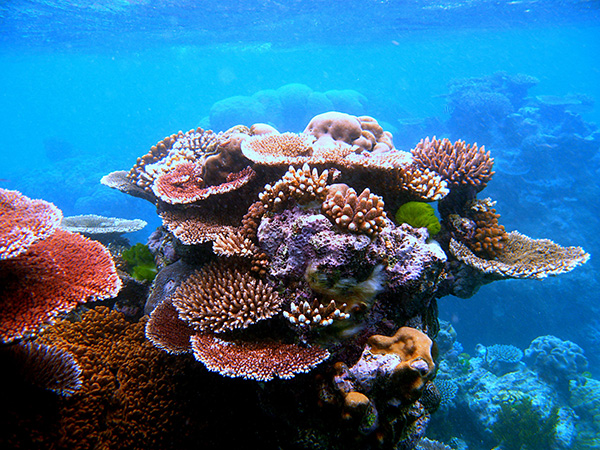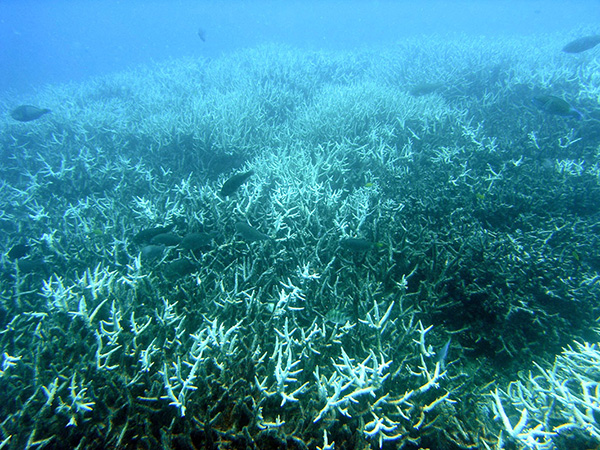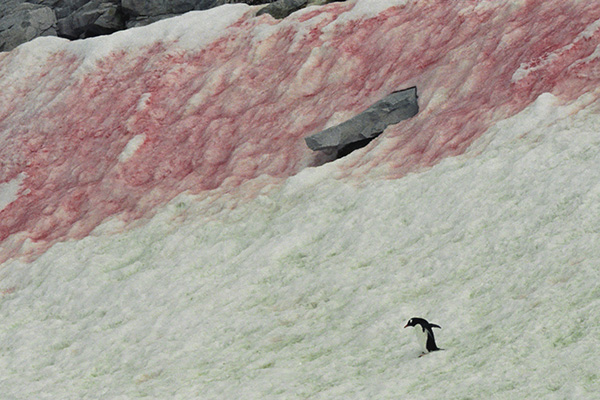
The resplendent colours of coral reefs are the result of the symbiotic zooxanthellae life that support the coral.
RECENTLY, I was giving a talk on this subject only to be interrupted by a keen conservationist. He abruptly asked, “Speaker, do you not mean, white snow and red coral?” I told him to be patient and to listen more carefully to what I was about to say. I then explained that whilst falling snow is white as, goodness knows, I’ve seen much of this in my lifetime and also explored red coral reefs, but times are changing.
Around 25 to 30 years ago, in summer time, I trekked over the higher points of the Austrian Tyrolese Alps with my family and observed red snow patches preserved in shaded hollows near alpine summits. In my ignorance, I thought that these pinkish/red snow patches had absorbed iron from the mineral composition of the underlying bedrocks and were thus stained. Little then did I know.
Red snow
Pink or red snow, or as the Americans call it ‘watermelon snow’, is not as unusual as some may think. The London Times, in 1818, recorded an entry on the arctic explorer, Captain James Ross’, discovery of pink/blood red snow on the edges of the Greenland glaciers and ice-cliffs of that vast ice cap. Ross brought back samples of this pink reddish snow, in melted form, to the United Kingdom for scientific analysis. Later, Ross explored Antarctica, hence the Ross ice-shelf and the Ross Sea in his name. The Times succinctly noted that the colouration of the Arctic ice was derived from the soil. Little then was really known about climate change or global warming. Ross had described the white glacier cliffs of Greenland as, “like streams of blood or like the spillage of red port wine”.
Whilst walking over residual summer snow patches in Austria. I noticed that the white soles of my climbing boots sunk low into the red snow and were stained in a pinkish slush colour and this reminded me of Ross’ observations many moons before. When I trod on the snow patches, compression naturally occurred and enforced melting resulted in producing a watermelon juice-like aqueous liquid. Suffice to say I did not dare to taste the slushy snow for I was aware of the snowfield’s capacity to absorb European atmospheric pollution.
It was at the very end of the 19th century that red snow was attributed to the growth of melting snow-loving algae and, indeed, ‘blooms’ of this primitive form of plant life. The most common form of this cold-loving algae, Chlamydomonus nivalis, is also found in proliferation in the high alpine range mountains of the western United States. Besides chlorophyll, the algae contains a very bright ceratoid pigment (not unlike a carrot). Compaction by climbers and trekkers merely increases the density of the red cells in the algae.
Interestingly, these dark red pigments absorb more and more of the sun’s heat and so they proliferate. Their dark colours absorb yet more heat leading to an increased melting of the ice/snow surfaces. White snow has a high reflective albedo, whereas red snow has a smaller reflection capacity and thus greater absorption of the sun’s energy. This not unlike the heat reflected or absorbed by the different colours of main road surfaces in Malaysian urban areas and on freeways.
In 2012, from aerial photographs, it was estimated that 97 per cent of the whole of the Greenland ice cap was affected by surface melting. This is a Catch-22 situation, for as melting occurs so more algae grows absorbing even more heat leading to a gradual rise in sea levels worldwide. Spare a thought for those nations and their people living near coastal areas as the Arctic-circle ice masses continue to melt. Many low-lying and coastal communities, in the Maldives and in Southeast Asia, both physically and economically, because of their very locations, are thus affected by the continued growth of red snow as melting continues.

Reef bleaching has left behind ghostly white and barren reefs.
White coral
Red coral necklaces, earrings and bracelets fetch high prices in the jewellery trade. My personal coral treasures are two chunks of bleached and dead white coral that I found washed up in discarded fishing nets at Tanjung Aru, Kota Kinabalu many years ago. Snorkelling in the Indian Ocean, off the Kenyan and Madagascar coasts, I have seen the splendours of red coral reefs. Interestingly, the ceratoid pigments found in the algae growing on red/pink snow are also found in corals, shrimps, prawns, lobsters and even in pink flamingos.
The resplendent colours of coral reefs are the result of the symbiotic zooxanthellae life that supports the coral. When coral is under threat or stressed, these creatures are expelled by the coral polyps. Rising sea temperatures, caused by global warming, and particularly in shallow seas, force the zooxanthellae to abandon the coral reef and the symbiotic chain is suddenly broken. Such is the end of coloured corals and the beginning of reef bleaching. The El Nino effect of 1997 to 1998 caused a rapid rise in sea temperatures and saw the demise of many colourful coral reefs in the Indian Ocean and Caribbean. This event killed off nearly 80 per cent of all shallow water corals in the Indo-Pacific oceans, leaving behind the ghostly white, barren reefs that we may see today.
Other threats to coral reefs such as barnacles, crabs, fish, marine worms, sea snails, and the dreaded starfish, the crown-of-thorns, slowly consume all living coral tissue. Nearly 90 per cent of the coral reefs in American Samoa were destroyed by the 1978 outbreak of the crown-of-thorns starfish and as I write, currently the Great Barrier Reef in Australia is suffering in much the same way. Hurricanes, typhoons, tropical cyclones, and tsunamis can obliterate coral reefs and put surviving coral species under great stress. Deep water trawling, with nets heavily weighed down to scrape the seabed, also causes infinite damage to coral reefs. The illegal practice of dynamite and cyanide fishing, together with dredging of the calcite in coral reefs for the construction industry, all add to the destruction of the coral colours of our undersea world.
The solutions to keeping snow white and coral red lie firmly in our hands. Winter sports enthusiasts rely on white snow as much as snorkelers and divers depend on colourful red coral reefs. Local sources of revenue from the tourist industry will decline if the snow continues to rapidly melt and the coral becomes bleached. Villagers will suffer from the demise of the trickledown effect of a once-thriving and soon defunct tourist trade.
Malaysia is setting an example for other maritime nations by gradually creating more and more marine parks to preserve its marine biodiversity as a national treasure of great value. Clearly Malaysia recognises the value of its tourist industry to the national economy as well as the importance of fish protein in its people’s diet. May very many other nations follow Malaysia’s example.
The person who initially interrupted my talk later apologised for his hasty intervention. I politely thanked him, for his question did, in fact, make others think again.

A penguin walks down a slope in Antarctica where red snow affected by algae can be seen.
